
In a significant shift in federal employment and contracting policy, former President Donald J. Trump revoked Executive Order 11246, a foundational civil rights mandate that had governed affirmative action and non-discrimination for nearly six decades. This bold decision, issued via Executive Order 14173 on January 21, 2025, was part of a broader initiative to end what Trump described as “illegal discrimination and wasteful DEI (Diversity, Equity, and Inclusion) programs” in government and federally funded projects.
This article explores the history, impact, legal implications, and future ramifications of revoking Executive Order 11246. We’ll break down what the order was, why it mattered, and how Trump’s repeal reshapes the federal landscape on civil rights and employment equity.
What Was Executive Order 11246?
Executive Order 11246 was signed by President Lyndon B. Johnson on September 24, 1965. It prohibited federal contractors and subcontractors from discriminating in employment decisions on the basis of:
- Race
- Color
- Religion
- Sex
- National origin
The order was later amended:
- EO 11375 (1967) added protections based on sex
- EO 13672 (2014) added sexual orientation and gender identity
It authorized the Office of Federal Contract Compliance Programs (OFCCP) under the Department of Labor to enforce compliance by contractors and subcontractors, including mandatory affirmative action plans.
📊 Executive Order 11246 Overview
| Attribute | Description |
|---|---|
| Issued by | President Lyndon B. Johnson |
| Date | September 24, 1965 |
| Purpose | Prohibit discrimination by federal contractors |
| Enforced by | Department of Labor (OFCCP) |
| Later Amendments | EO 11375 (sex), EO 13672 (LGBTQ+ protections) |
| Affected Parties | Over 25,000 federal contractors and subcontractors nationwide |
Why Did Trump Revoke Executive Order 11246?
On January 21, 2025, President Donald Trump signed Executive Order 14173, titled “Ending Illegal Discrimination and Restoring Merit-Based Opportunity.”
Key Motivations Behind the Repeal:
- Opposition to Affirmative Action: Trump characterized affirmative action as a form of reverse discrimination.
- Government Overreach: The administration argued that EO 11246 promoted quotas and race-based preferences.
- “Merit-Based” Policy Agenda: The repeal fits Trump’s broader strategy to favor individual merit over identity-based criteria.
- DEI Backlash: The administration sought to dismantle diversity, equity, and inclusion (DEI) efforts in federal institutions.
What Did EO 14173 Actually Do?
EO 14173 explicitly revoked Executive Order 11246, along with its amendments (EO 11375 and EO 13672). It also:
- Prohibited federal agencies from using race, sex, or other identity categories in hiring or contracting considerations.
- Ended mandatory affirmative action requirements for federal contractors.
- Ordered the Department of Labor to cease enforcement under EO 11246.
- Gave contractors a 90-day grace period (until April 21, 2025) to wind down affirmative action programs.
📜 Key Legal Provisions of EO 14173
| Provision | Description |
|---|---|
| Revocation Clause | Explicitly nullifies EO 11246 and its subsequent amendments |
| Enforcement Halt | Suspends OFCCP enforcement of EO 11246 |
| Merit-Based Directive | Mandates hiring decisions be made solely on qualifications |
| Implementation Period | 90-day grace period for contractors to comply with the new directive |
Impact on Federal Contractors
Who Was Affected?
- 25,000+ federal contractors
- Major corporations in defense, healthcare, tech, education, and construction
- Minority-owned and women-owned businesses that benefited from affirmative action
Immediate Effects:
- Affirmative Action Plans: No longer required.
- OFCCP Reviews: Ceased for race/gender-based compliance.
- EEO Clauses in Contracts: Removed or modified.
- Training & DEI Programs: Cut back or halted entirely.
📈 Federal Contractor Landscape Pre- and Post-EO 14173
| Metric | Before EO 14173 | After EO 14173 (Post-April 2025) |
|---|---|---|
| Required Affirmative Action | Yes | No |
| OFCCP Audits | Active | Suspended |
| DEI Compliance Training | Mandatory for many | Optional/Defunded |
| Protected Identity Categories | Race, gender, etc. | No consideration allowed |
Legal and Political Reactions
Supporters’ Views:
- Conservatives and business advocates hailed the repeal as restoring fairness and reducing red tape.
- Emphasized “colorblind” policies and elimination of “preferential treatment.”
Critics’ Views:
- Civil rights groups, Democrats, and progressive legal scholars condemned the repeal.
- Warned of increased workplace discrimination, less accountability, and fewer opportunities for minorities and women.
- NAACP, ACLU, and Lambda Legal issued joint statements warning of potential regressions in civil rights.
Lawsuits and Legislative Pushback:
- Multiple lawsuits were filed by advocacy groups in federal courts seeking injunctions.
- Democratic lawmakers proposed bills to codify EO 11246-style protections into federal law.
Comparison with Other DEI Rollbacks
Trump’s revocation of EO 11246 is part of a broader initiative that included:
- EO 14151 – “Ending Radical and Wasteful Government DEI Programs”
- Rescinding DEI training requirements for federal employees
- Repealing Executive Orders promoting environmental justice and equity
This places EO 14173 within a coordinated rollback of the Biden-era inclusion initiatives and a wider cultural movement opposing DEI programs in corporations and universities.
Broader Societal Impact
1Workforce Demographics
Without affirmative action mandates:
- Fewer hiring incentives for marginalized groups
- Corporate pipelines may shrink for women and minorities
Corporate Behavior
Many companies voluntarily maintain DEI programs, but some may roll them back to align with federal shifts or avoid legal risk.
Higher Education Influence
Although EO 11246 applied to contractors, the message echoes broader conservative efforts to limit race-conscious admissions and hiring, especially post-Supreme Court decisions.
Personal vs. Policy: The “Life” of Executive Order 11246
While not a person, EO 11246 had a profound “biographical” arc.
🧾 Biography-Style Overview: Executive Order 11246
| Attribute | Details |
|---|---|
| “Born” | September 24, 1965 (under LBJ) |
| “Amended” | 1967, 2014 (to include sex, sexual orientation) |
| “Revoked” | January 21, 2025 (under Trump) |
| Role | Combat employment discrimination in federal work |
| Legacy | 60 years of affirmative action and DEI policy |
| Cause of Death | EO 14173 – Policy shift to merit-only hiring |
What Remains in Place?
It’s important to note that revoking EO 11246 did not erase all workplace civil rights protections.
Still Enforceable:
- Title VII of the Civil Rights Act (1964)
- Americans with Disabilities Act (ADA)
- Age Discrimination in Employment Act (ADEA)
- Rehabilitation Act – Section 503
- Vietnam Era Veterans’ Readjustment Assistance Act (VEVRAA)
These statutes still prohibit discrimination—but they do not require affirmative action.
Public Sentiment and Polling
Recent polls showed:
- 55% of Americans support some form of affirmative action in government contracting.
- 40% supported Trump’s decision, citing concerns about fairness and reverse discrimination.
- Strong generational divide: Gen Z and Millennials largely opposed the repeal.
What Comes Next?
As the 2026 midterms approach and the 2028 presidential race begins to stir, EO 14173 may become a major flashpoint in debates about civil rights, meritocracy, and government reform.
Possible Outcomes:
- Legal challenges could overturn parts of EO 14173
- A future president could issue a new EO reinstating 11246-like provisions
- Congress may pass legislation to codify affirmative action standards into federal law
Conclusion
So, did Trump revoke Executive Order 11246? Yes—decisively and completely. The move marked a pivotal rollback of one of the most impactful civil rights policies of the 20th century, sending shockwaves through corporate, legal, and political spheres. While statutory civil rights laws remain, the affirmative action engine of EO 11246 has been dismantled, with effects still unfolding across the nation.



